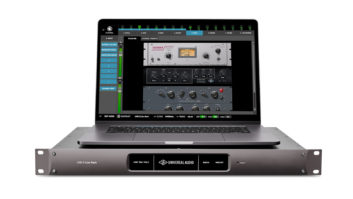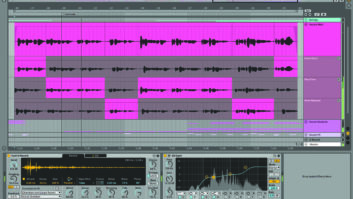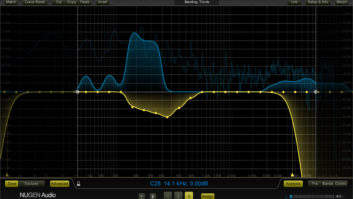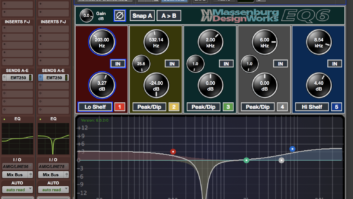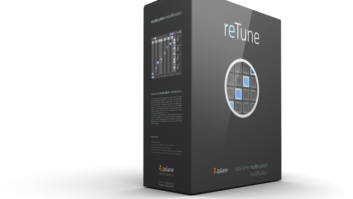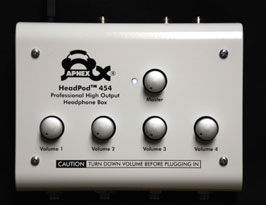
APHEX HEADPOD 454
High-Output Personal Headphone Amp
The HeadPod™ 454 from Aphex is a 1-input/4-output headphone amp. Priced at $249, it works in many situations, including computer-based production, location recording (if AC is available) and live sound, but I found that the 454 excelled in tracking loud instruments (i.e., drums) and providing detail at low levels.
With the 454’s “high output” as a prime selling point, Aphex provides an output vs. impedance chart that indicates a maximum level for each of the four headphone outs at approximately 1,200 mW (8 ohms) diminishing down to 110 mW (600 ohms). The form factor is small, coming in at 5.5×2×4.25 (W×H×D) inches, about three-quarters the size of a PreSonus HP4, but the 454 isn’t rackmountable — it’s a tabletop unit.
The 454 is a sturdy box that should stand up to daily use and a lot of moving around. The top-mounted controls are straight-ahead: one master volume and four individual output controls for each output channel, all continuously variable. Inputs are metal TRS jacks (another plus for ruggedness), with a 20k-ohm input impedance and a maximum +24dBu input level. A rear panel switch selects the dual, balanced TRS inputs for left/right signals, or the single, unbalanced TRS input, which can be used for L/R signals coming from the output of a soundcard, portable computer or any source that needs a kick in volume. Power is provided by a 12VAC wall wart.
I A/B’d the 454 with a PreSonus HP4 using a 250-ohm Beyer DT770 Pro, a 65-ohm Audio-Technica ATH-M30, a 63-ohm Sony MDR7506 and 600-ohm AKG K40M headphones. I referenced mastered, commercially available CDs, as well as 24-bit/96kHz original Pro Tools files, both of which had plenty of punchy drum tracks. The DT770s reached their limits before either headphone amp. The ATH-M30s were a different story: The 454 had more headroom. I reached the limits of the HP4, but the 454 gave that extra kick that started moving the headphone pads away from my head, simply from the SPL. The MDR7506s produced similar results — both amplifiers had more drive than I could stand. With their higher impedance, the AKG K40Ms were definitely better served by the 454. At low levels, I noticed subtle differences in ingredients up front in the mix when compared to the output of the HP4. Vocal ‘esses’ have a bit more detail, along with the rest of the vocal range, particularly in the upper-harmonic structure. Reverb tails had a bit more separation from the primary signals.
Bottom line: Clean is the name of the game with the 454. At high and low levels, this box provides plenty of gain and detail at both ends of the SPL scale.
Aphex, www.aphex.com.
— Bobby Frasier
AUDIX M1250
Micro Series Miniature Microphone
One of the latest trends in microphones is the miniature pencil-style mic. Somewhere between a lavalier and a full-sized, front-address mic, the M1250 transducer-on-a-diet from Audix is great for applications where sneaking in between cymbals to mike a tom or going under a snare can be difficult. Its size is also great for spoken-word applications, in which seeing the person’s face on camera or at a podium is important. It also offers total immunity from RFI, making it a winner for use around GSM phones and devices. The phantom-powered Audix M1250 mic certainly fits any of the previously mentioned applications and more.
Although I tested versions with cardioid capsules ($419), Audix also offers hypercardioid ($439), omni ($419) and supercardioid ($459) capsules, making this one of the most versatile mics in its class. It comes with a 25-foot mini- to full-sized XLR cable, a mic stand adapter, hanging clip, foam windscreen and carrying pouch. Optional accessories include a 50-inch Microboom, stand adapter with rubber shock-mount, lug and drum-rim mounts, and goosenecks in three sizes.
Measuring just two inches long and a half-inch in diameter, this 0.6-ounce wonder has a frequency response of 80 to 20k Hz, and boasts being the smallest 48-volt condenser mic with an integrated preamp on the market. I tried two M1250s in a number of situations with varying results. I first used them on toms, and due to their size found them a breeze to place just right. The mics advertise a bottom end down to 80 Hz, but they needed some help from a bottom tom mic (flipped out of polarity) to get the sound I was looking for. They handle 150dB maximum SPL, so close proximity to a drum is not a problem. The attack of the stick on the tom was crystal-clear, and transient response was excellent. I did find them lacking as overheads, but these wouldn’t be my first choice anyway. These miniature mics are better suited for tight, high-SPL situations — both live and in the studio.
Next, I tried an M1250 under a snare paired with a Shure SM57 on top. It brought out the snap I was looking for and was a perfect companion for the top mic. For spoken word, these mics shined. Their rolled-off bottom and ability to take high SPLs made them a perfect choice when used up close, especially with the included pop screen.
Although I did like using the mic in a variety of applications, I had a few problems with the optional drum-mounting hardware that Audix sent. I’m not big on this style for studio recording, but for live applications it helps to eliminate stage clutter. The clamps were robust, but I found the rubber shock-mounts to be flimsy and they broke easily after minimal use. However, the optional long and elegant Microboom floor stands are exemplary. I could see this mic being ideal for house of worship or other podium applications where you need good spoken-word coverage but don’t want a large mic in someone’s face.
Audix, 503/682-6933, www.audixusa .com.
— Kevin Becka
BRAINWORX BX_HYBRID 2
Equalizer Plug-In
The 11-band mono and stereo bx_hybrid 2 ($349) VST/RTAS EQ plug-in from Brainworx combines unique features with traditional tools. As you’d expect, filter choices include low shelving, high shelving, bell, lowpass, highpass and notch, with sweepable bass and presence-shifting EQs that are joystick-controllable. The extras include Auto-Listen modes; M/S stereo width and M/S “Mono Maker” controls; a dual-mono layout for linked and unlinked control of each individual feature; individual bypass switches for every feature; balance and phase correlation meters; and solo’ing capability for left and right channels, which puts the signal from the individual channel into both speakers. A switchable EQ panel with multimode EQ display ties all these fully automatable functions together.
The old-school core of bx_hybrid results from its creators’ understanding of the mysteries of M/S. By applying M/S principles internally to a mixing/mastering EQ, brainworx has made this complex technique foolproof and easily accessible for DAW-based production. The Mono Maker control at the top of bx_hybrid’s large and attractive interface allows you to change the low end to mono from 0 Hz up to any desired frequency. It creates a mono mixdown low while automatically compensating for any potential loss of overall bass amount in the mix.
When I applied bx_hybrid to the bass, drums, percussion and synth stems of an electronica mix, the benefits of this capability were immediately apparent. I started by making the bass mono at 44 Hz with a stereo width decreased down slightly from 100 percent (you can take it as high as 400 percent), resulting immediately in a nicely tightened, better-focused bass track. From there I introduced the Mono Maker and stereo-width controls, making incremental increases in those parameters for each stem. The result was a startling increase in control for placing each stem in the stereo field and articulating its presence, in a way that would have been either impossible — or at least extremely time-consuming — without the hybrid on hand.
The software’s ability to solo the left or right signal in both speakers was invaluable for judging perspective on the mix, and the Auto-Listen modes — while tricky to comprehend at first — become intuitive with practice, allowing even greater insights as to how each band’s Q, gain and frequency adjustment impacted the audio.
The only difficulty I encountered was CPU drain: Putting one across each of four stems on my PC (2.26 GHz, 2GB RAM) in Cubase SX3 affected performance, although I solved the problem by freezing tracks. That issue notwithstanding, I was impressed with bx_hybrid’s ability to improve workflow and decision-making, which improved the final results in my mixes.
Brainworx, www.brainworx-music.de.
— David Weiss
GLYPH GT 062 RAID
High-Capacity Desktop Storage System
The GT 062 from Glyph is a half-rackspace desktop hard drive system comprising two Seagate SATA drives that run at 7,200 rpm and an Oxford 924 chipset. Available in sizes up to 2 TB, Seagate’s SATA drives are faster than traditional parallel ATA drives because SATA drives include a built-in Native Command Queuing (NCQ) algorithm. NCQ increases efficiency because it cuts down on extra arm motion by dynamically rescheduling and reordering commands so that the heads travel less over the platters.
The all-steel GT 062 has an internal power supply and is cooled by a superquiet fan. There are two FireWire 800 ports, along with FW400 and USB 2. The drive comes in a plastic travel case complete with cables for FW400, FW800 and USB, plus AC power, the Glyph Manager (GM) software and a three-year warranty, which includes a free, two-year basic data-recovery service.
Designed for pro A/V, the 062 is capable of a sustained transfer rate of 80 MB per second and supports four RAID drive modes. As Pro Tools and some other DAWs do not support software-based RAIDs, the GM software configures the firmware inside the 062 so it presents itself as JBOD (Just a Bunch of Discs), where the CPU sees two independent drives; “Spanning,” where data is written sequentially (when the first disc is filled, the remaining data is written to the second disc); RAID 0 (aka “Striping”), the fastest mode because both drives read and write concurrently; and RAID 1, or “Mirroring,” where data is written redundantly to both drives — a little slower, but the safest mode with half the total capacity of the two drives. If either drive fails, then the other will operate seamlessly. GM checks the health of each drive in RAID 1 mode and indicates a failure by bouncing in the Mac’s Dock.
I mounted my 1TB GT 062 next to my 250GB GT 050Q drive in a single rackspace using the optional dual-rackmount kit and daisy-chained the two to my quad-core Mac using FW800 cables. After installing the GM software, I selected RAID 1 mode. Changing RAID mode at any time necessitates the power cycling and erasing of the entire drive. I used the Mac’s Disk Utility to erase and turn the 062 into a Mac OS Extended (Journaled) volume. (Or for Windows PCs, a NTFS volume; Vista is not yet supported.)
I chose RAID 1 mode to offer to my mixing clients the added safety that all of their audio files and mixes would be redundantly stored on the 062. Even though I make a copy after each day’s work, it is possible that a read/write error or an actual drive failure could occur during a session.
I got the same speed, quiet operation and track count (as high as 120 with low edit densities) as my 250GB GT 050Q — with all the same performance in my Pro Tools HD3 Accel rig. The big difference was a sense of confidence that all my hard work was stored safely. Until solid-state storage becomes cheap enough, hard drives remain essential in A/V production; it’s imperative they always work accurately and reliably. The GT 062 fulfills that imperative. Prices: $452 (500 GB), $665 (1 TB), $1,092 (1.5 GB) and $1,425 (2 TB).
Glyph, 800/335-0345, www.glyphtech.com.
— Barry Rudolph


